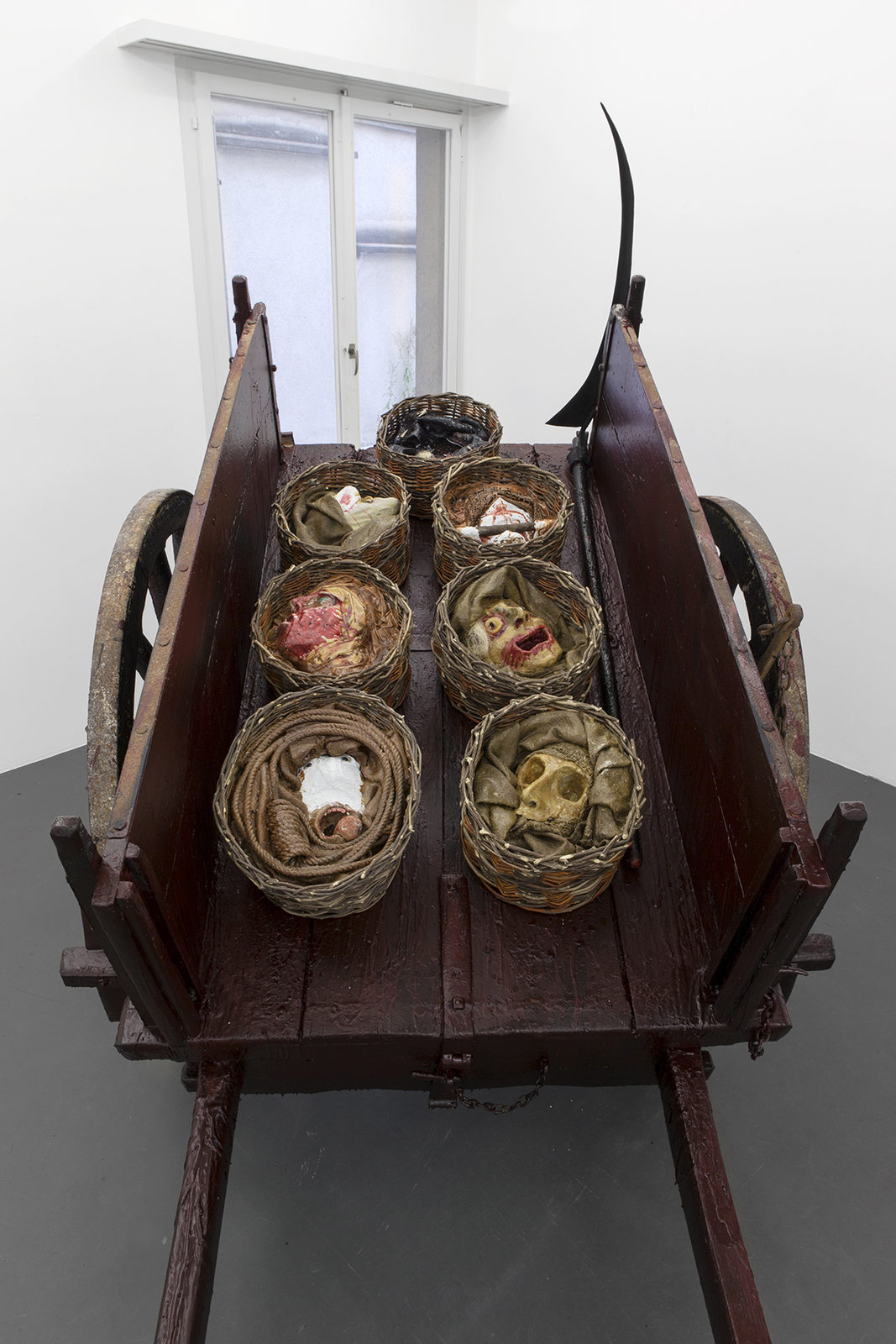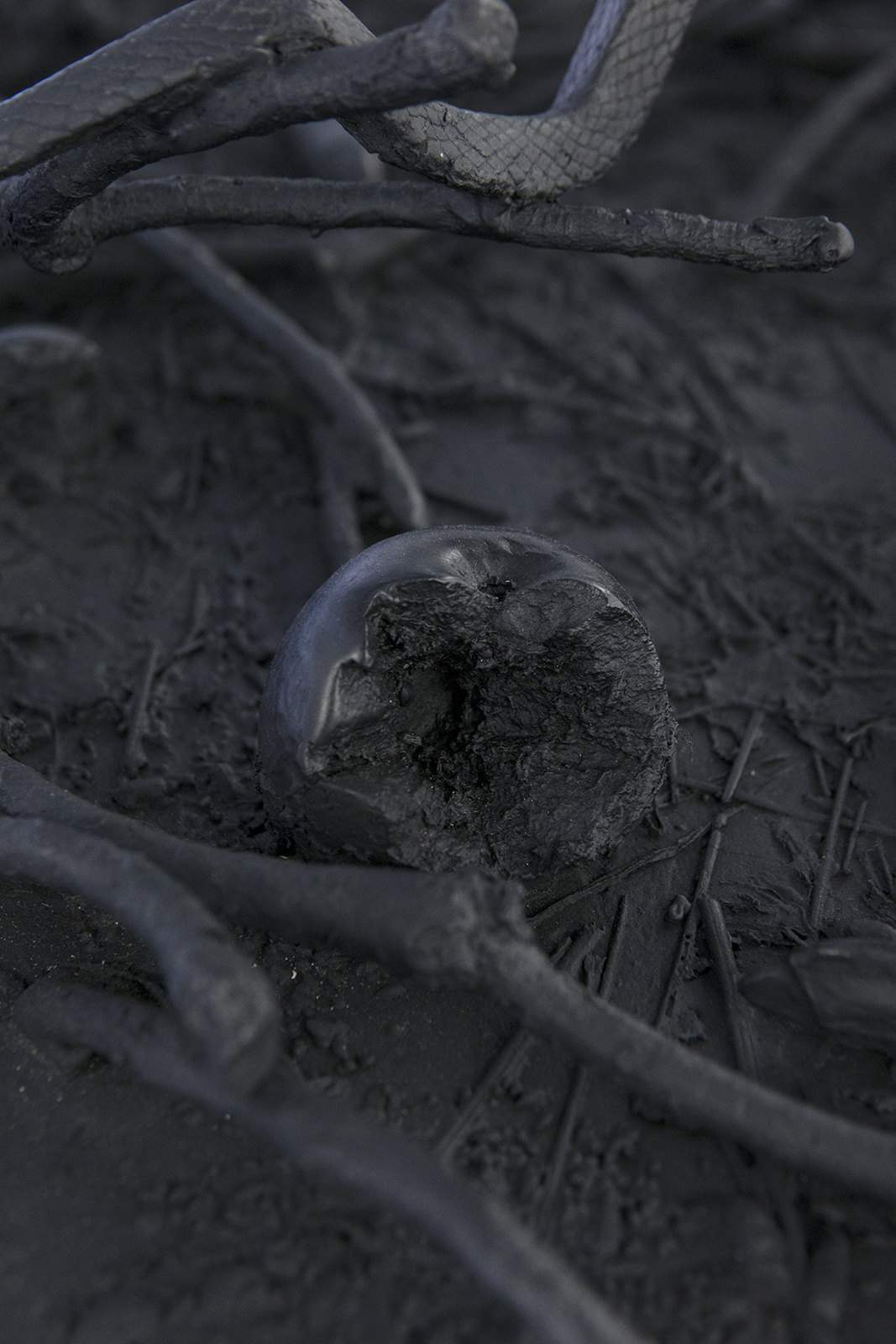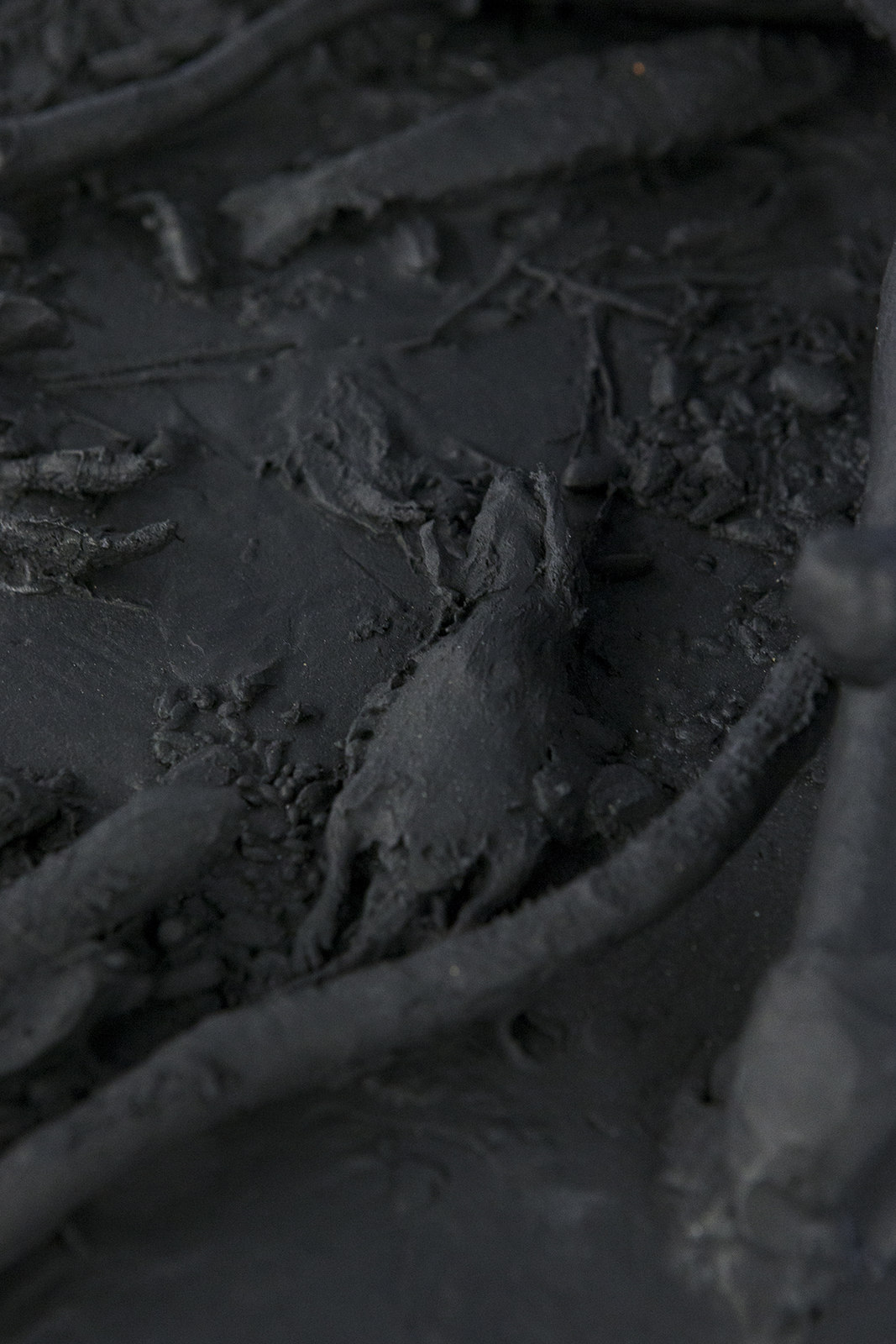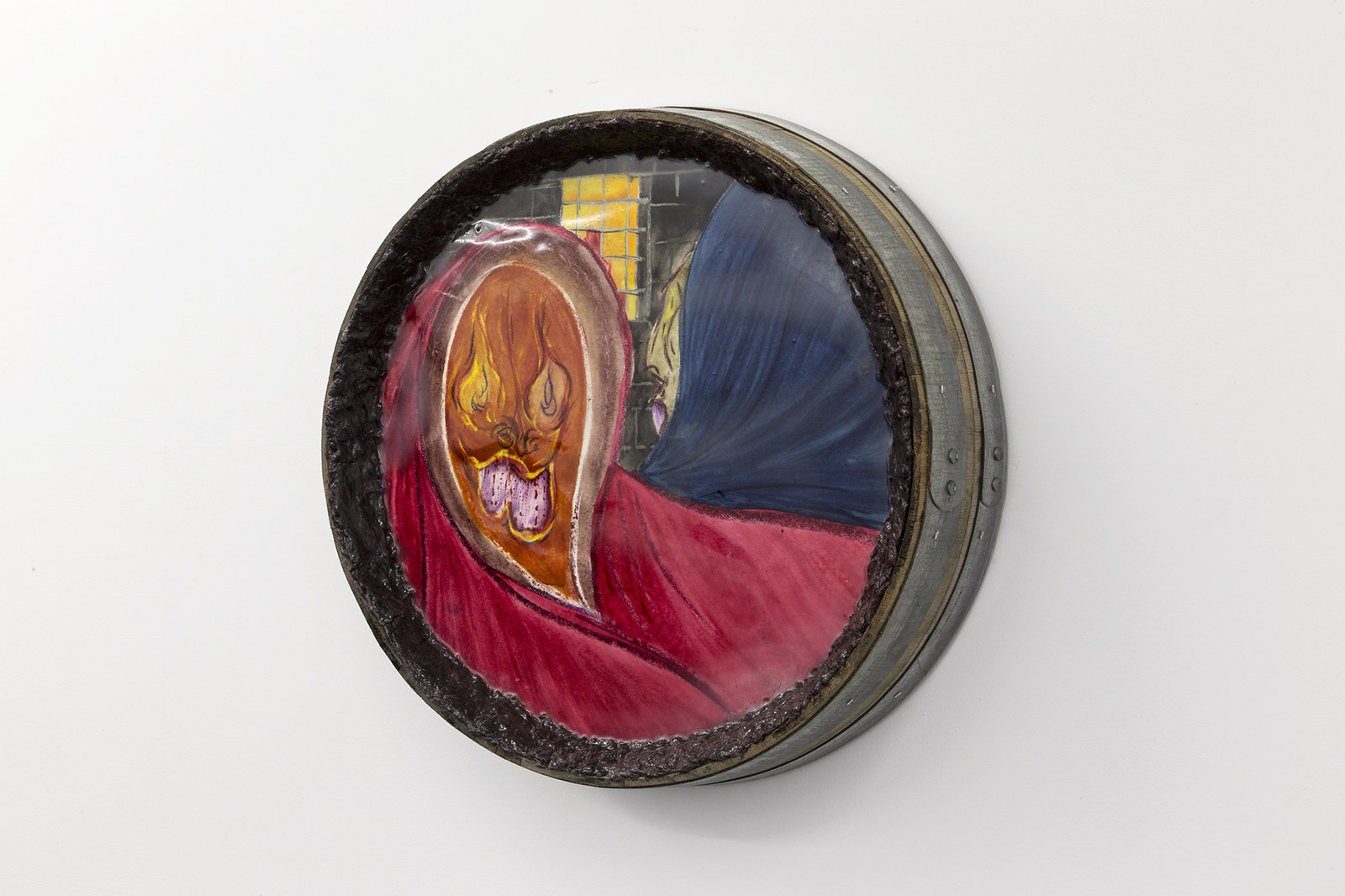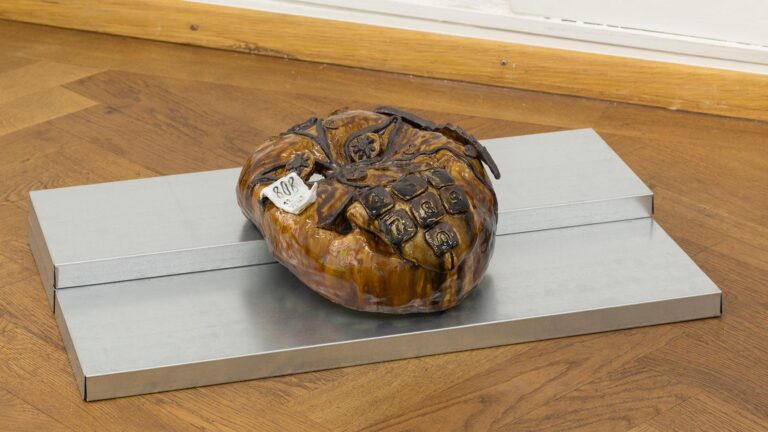Artist: Daniele Milvio
Exhibition title: Leggi e Credi
Venue: Weiss Falk, Basel, Switzerland
Date: December 9, 2016 – January 28, 2017
Photography: all images copyright and courtesy of the artist and Weiss Falk, Basel
Wolves & Villagers
Fairly long hair tied back with nonchalance in a ponytail behind the nape (suggesting a demonic inclination, according to the Gospel of Katharina Fritsch). Profoundly moved with an accompanying flickering that echoes a studied carelessness expressed in the concentric gestures of the wrists and percussions of the phalanges; this upon an accomplished posture with a timid flexure of the shoulders and consequential forward inquisitive traction of the back; a riot of words, metaphors and citations that swing between High and Low brow. It is he, on this night, our Master of Ceremonies.
Arrived in Basel from Rome via Milan, he has brought with him ‘An Essay on Ancient Mortuary Symbolism’ and its consequential visionary theory on the matriarchy by Johann Jakob Bachofen. A pilgrimage towards the birthplace of acclaimed Swiss historian and anthropologist as an additional interpretation on his own ancient Romanic roots or a ‘Bachofen’ as a pastime to appease the long crossing? The means of transport, a red lacquer sedan chair.
An august cabin with features of a passable papal brand over which six blindfolded symbols loom and anchor the two side poles: an ear to not hear; a mouth to not speak, whether it belongs to a rhinoceros or a Cyclops; a mutilated hand to not touch; the decapitated face of two beggars to never implore again. Neither astral nor alchemic symbols. Heraldic? Rather, they are personal protective deities, warnings, talismans or malismans. Protectors for wayfarers with special messages? The vehicle, nevertheless, clearly shows the traces of negligence caused by the weather and its state of abandon, as if it was parked for a cruel amount of time…it is now a shelter for a stork and its colourful ecosystem that has made its nest on the peak of the roof. She pecks at a serpent that was threatening one of her offspring; a few rats peer out, while grasshoppers, fish, two apples and a pomegranate offer themselves at the table for the newborn. On the side of the chair, still visible, an engraved phrase in Latin: “Quos timuit superat, quos superavit amat.” It is with this exact sentence that the Master of Cerimonies begins the game:
“Win those who you have feared, love those who you have won: proclaimed Rutilius Namatianus as he returned to his homeland of Gaul travelling through an Italy devastated by the Barbarians. The same advice I give to you, players. Pick a card from the deck, this will correspond to your identity, keep it hidden as long as you can, lie if needed, feign until you are beheaded. Many deaths will follow in the brief passing of a few days and nights. The Wolves will reconvene at night; the Villagers will present their defense in the day.” All painted by the great Master (of Ceremonies obviously), the characters are framed in circular sections of wine barrels. Amongst the positive characters, travel and adventure companions, appears the serene and cheerful young farmer, angelically asleep on his own sickle: of men and mortality we could say. The herdsman should also be paying more attention. The scene is idyllic where a chaffinch confuses the horns of his buffalo for a perch. A suspension. A stasis. The perfect locus amoenus but always near is the treacherous garden.
Like the knife grinder he also is a figure whose visage falls outside of the margins of representation. For both, a spirit animal is offered in the foreground. Accompanying the knife grinder a dog with a long and red snout, that, while changing fur (but most probably not vice), presents himself at the feet of the cardinal – maybe only a sage or a librarian – seated in front of an encyclopedic knowledge – the bookshelf is composed of volumes with the same enumeration. One dog, two owners. Perhaps the same person, two sides of the same coin. At times a fighter, at other times, a contemplator.
A pair of hands keep warm around a boiling cauldron, two blurry faces peer over a book and finally, two hooded characters sit in prison. Bizarre couples of individuals with undefined genders, disturbing yet benevolent vestals. What potion is being cooked on the scorching fire? Which spell is being cast as the air is befogged and the atmosphere benumbed? Who are the two immured facing out and away from us? Friars? Hermits? Mystics? What prophecy has forced them into segregation?
The resolution of the game comes in a flash presenting the configuration of a last tableau vivant.
Dominating high is the hyperbola of a sickle, used to punish false witnesses, according to the Book of Zachary. In a cart, ready to be transported offstage, hidden inside wicker baskets, seven beheadings. “Not all have found their honorable end in decapitation. There are some who ended up under our wheels, some who had melted metal poured down their throats. Others died of thirst. Only one was hung. Another was torn to pieces. The last was tied up and eaten by crows.”
The villagers have triumphed this time.
– The game Wolves & Villagers (sometimes known as Werewolf) is a party game based on Mafia, created by Dmitry Davidoff in 1986. The game, taking place in two phases, night and day, sees the players debating the identity of the culprits (Wolves) who covertly murdered innocents (Villagers). There are also Villagers with special powers including the Clairvoyant and the Witch.
Text by Milovan Farronato
Daniele Milvio, Rutilio, 2016
Cotton Paper, Resin, Gouache, Wax, Ink and Oil Pastel on Barell, ø 63 x 15 cm
Daniele Milvio, Quos timuit superat, quos superavit amat, 2016
Bronze, Wood, Wax and Fabric, 243 x 250 x 220 cm
Daniele Milvio, Quos timuit superat, quos superavit amat, 2016
Bronze, Wood, Wax and Fabric, 243 x 250 x 220 cm
Daniele Milvio, Quos timuit superat, quos superavit amat, 2016
Bronze, Wood, Wax and Fabric, 243 x 250 x 220 cm
Daniele Milvio, Quos timuit superat, quos superavit amat, 2016
Bronze, Wood, Wax and Fabric, 243 x 250 x 220 cm
Daniele Milvio, Quos timuit superat, quos superavit amat, 2016
Bronze, Wood, Wax and Fabric, 243 x 250 x 220 cm
Daniele Milvio, Quos timuit superat, quos superavit amat, 2016
Bronze, Wood, Wax and Fabric, 243 x 250 x 220 cm
Daniele Milvio, Ti dono un coltello e un motivo per averlo, 2016
Cotton Paper, Resin, Gouache, Wax, Ink and Oil Pastel on Barell, ø 63 x 15 cm
Daniele Milvio, Nunzio, 2016
Cotton Paper, Resin, Gouache, Wax, Ink and Oil Pastel on Barell, ø 63 x 15 cm
Daniele Milvio, Magnifico Rettore, 2016
Cotton Paper, Resin, Gouache, Wax, Ink and Oil Pastel on Barell, ø 63 x 15 cm
Daniele Milvio, Quando mangio combatto contro la morte, 2016
Cotton Paper, Resin, Gouache, Wax, Ink and Oil Pastel on Barell, ø 63 x 15 cm
Daniele Milvio, Untitled, 2016
Wood, Wax, Steel, Bast Baskets, Plaster, Fabric and Bronze, 172 x 170 x 418 cm
Daniele Milvio, Ugo Soragni, 2016
Mixed Material in Bast Basket, ø 43 x 25 cm
Daniele Milvio, Peter Aufreiter, 2016
Mixed Material in Bast Basket, ø 43 x 25 cm
Daniele Milvio, Paolo Baratta, 2016
Mixed Material in Bast Basket, ø 43 x 25 cm
Daniele Milvio, James Bradburne, 2016
Mixed Material in Bast Basket, ø 43 x 25 cm
Daniele Milvio, Flaminia Gennari Santori, 2016
Mixed Material in Bast Basket, ø 43 x 25 cm
Daniele Milvio, Eike Schmidt, 2016
Mixed Material in Bast Basket, ø 43 x 25 cm
Daniele Milvio, Cristiana Collu, 2016
Mixed Material in Bast Basket, ø 43 x 25 cm
Daniele Milvio, Un giorno vorró il mio bene piú del tuo male, 2016
Wood and Bronze, 140 x 90 cm
Daniele Milvio, Maggior Consiglio II, 2016
Cotton Paper, Resin, Gouache, Wax, Ink and Oil Pastel on Barell, ø 63 x 15 cm
Daniele Milvio, Abbrutiti dall‘insonnia, 2016
Cotton Paper, Resin, Gouache, Wax, Ink and Oil Pastel on Barell, ø 63 x 15 cm
Daniele Milvio, Origini del buco del naso, 2016
Watercolour, Ink and Oil Pastel on Canvas, 198 x 120 cm

